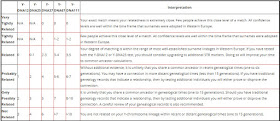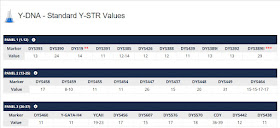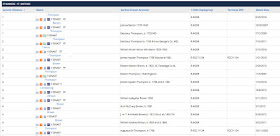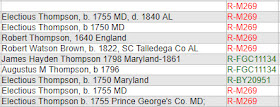If you've taken a Y-chromosome DNA test from Family Tree DNA, your first test showed the results of Short Tandem Repeats (STRs). Below are the results of a 37-marker test:
These results are meaningless on their own; they are only useful when compared to the results of others. So your list of Y-DNA matches becomes critical. Are 37 markers enough to tell us what we need, and is there any point in upgrading?
How Family Tree DNA determines matches
In addition to your STR results, Family Tree DNA will give you a list of men whose Y-DNA results match yours. These matches are based on the number of markers tested and genetic distance. Genetic Distance is the number of differences, or mutations, between two sets of test results..
If you order a 37-marker Y-STR test, FTDNA will show another man as a match to you if there is a genetic distance of 4 or less. If you test 67 markers, your match must have a genetic distance of 7 or less. At 111 markers your match list contains people who match you at a genetic distance of 10 or less.
Sometimes you have matches to other men with your surname. Sometimes you have no matches at all, and sometimes you have so many matches that it's difficult to determine which ones are actually related to you. We will examine these three types of results to see if it may be useful to upgrade STR markers.
Surname matches: How closely related are we?
If you have matches to other people with your surname, you want to determine how closely related they are.
At 37 markers, my brother has 17 matches. Only people who tested 37 markers or more can appear on this match list. In the first column of the match list the Genetic Distance (GD) is shown. Because the cut off for 37 markers is a genetic distance of 4, anyone who has a GD of five or more at this level will not be on the list.
The genetic distance is reported, but we can't see which markers are matching. We can only know the actual results by joining projects or by contacting each person on the list.
In this case, my brother joined the Thompson DNA Project. Below are the results for some of the Thompsons who match him. Comparing kit 34484 to kit 38962, we can see a genetic distance of four--one mismatch each at DYS448, DYS456, DYS576, and CDY.
There seem to be a few markers that are distinguishing between different groups of descendants from the common Thompson ancestor. At DYS448 four men have a 19, and the four below them have a 20. The four men who have a 19 at DYS448 also have an 18 at DYS576, and the four men who have 20 at DYS448 have a 17 at DYS576. These markers can be considered signature markers that will allow us to help place the men within the Thompson family tree.
One of these men has a proven descent from Robert Thompson who was the immigrant ancestor to Colonial Maryland. Perhaps all of these men descend from him. But the 37-marker test indicates that the men with a genetic distance of four could be more distantly related and may share a common ancestor further back that Robert Thompson. Family Tree DNA shows the likelihood of relationships in the table below:
 |
| Family Tree DNA Relationship Table |
At a genetic distance of 4 at 37 markers, the interpretation column states "it is unlikely that you share a common ancestor in recent genealogical times (one to six generations). You may have a connection in more distant genealogical times (less than 15 generations).
At 37 markers and a genetic distance of four, we have no way of knowing whether the relationship is closer to six or 15 generations. We could be discouraged and decide that there may be no point in spending a lot of time trying to find our common ancestor. There also may no point in upgrading to 67 markers where we will likely see more mismatches.
But one-by-one, we upgraded anyway. Each person who upgraded encouraged others to do so. Here are the Thompson results for markers 38-67:
In the panel of 38-67 markers, there is only a single mismatch in this Thompson group. Some of these men were a genetic distance of four at 37 markers. They are still a genetic distance of four at 67 markers. Looking at the Family Tree DNA Relationship Table above, we find the genetic distance of 3-4 in the Y-DNA 67 column. It now indicates, "Your degree of matching is within the range of most well-established surname lineages in Western Europe."
Without these extra markers, we may not have tried to find the common ancestor. But with 67 markers, it appeared more likely that we may be able to find a common ancestor within the genealogical time frame, and, indeed, we did. The common ancestor of almost all of these men has now been proven to be George Thompson, the son of Robert the immigrant. In this case more markers helped to more closely determine degrees of relationship. The upgrade to 67 markers was very important in this surname group.
When men in a surname project notice that others are upgrading their STRs, they are more likely to do the same. In addition, when men compare STRs, there is one more important piece of information that helps encourage them to do further testing: an indication of SNP testing is included next to the STR results.
In the example above, seven of the men have not done any SNP testing. We know this because their haplogroup R-M269 is listed in red. A haplogroup in red is the predicted haplogroup provided by Family Tree DNA. Haplogroups listed in green mean that these men have conducted SNP testing. Two of the men have tested positive for the SNP FGC11134. One of the men has taken the Big Y test, and as soon as this was discovered another Thompson quickly followed suit. We are now awaiting the second set of Big Y results.
Upgrading STR results not only encouraged others to upgrade their STRs, but also encouraged them to do SNP testing.
No matches
My cousin has 240 matches at 12 markers and 24 matches at 25 markers. At 37 markers, my cousin has no matches at all.
The number of matches has gone done at each level of testing. Of course, when he joined his surname project, he had no matches. Here is a case where testing 67 markers would appear to be futile. But again, we did it anyway:
At 67 markers, he has one genealogically relevant match. This man had not joined the surname project, so there would be no way to find this match without a 67-marker test.
Too many matches
In contrast to the cousin with no matches at 37 markers, another cousin has 1610.
To cut that list down to a more reasonable number, I upgraded the STRs to 67 markers:
The number of matches actually went up! He now has 2252 matches at 67 markers. The list contained multiple surnames, so in this case the haplogroup project was more useful than the surname project.
Because STRs can mutate up in one generation and back down in another, STR results can indicate that people are more closely related than they actually are. This is called convergence. A match list of 2252 men (and multiple surnames) is an example of this. It is difficult to determine how closely these men are related. However, a significant number of these people have tested 111 markers. Will upgrading to 111 increase or decrease the number of people on the match list?
Upgrading to 111 markers made a big difference. It cut the match list from 2252 to 138. This is not because few of the men have tested 111 markers; it's because at 111 markers most of most of the men on the previous list were no longer matching. Their genetic distance at 111 markers was now greater than the threshold of 10 that FTDNA will consider to be a match. My cousin's closest match at 111 markers is a genetic distance of 7, so many of the men on the previous lists are now gone.
What does upgrading markers do?
- Upgrading helps to more precisely determine time to the Most Recent Common Ancestor.
- Upgrading may add new matches when someone previously had few or none.
- Upgrading may cut down the list of matches when someone previously had too many.
- Upgrading helps determine subgroups of men who may be related. For example, some of the men in the Thompson project only tested 12 markers. But at 37 markers, we could see signature markers dividing these men into two groups. Upgrading them all to 111 could further differentiate the lines.
- Upgrading STRs and conducting SNP tests encourages others to do the same.
- Upgrading STRs provides model haplotypes that help others decide what testing to consider. Tests that have both 111 STRs and Big Y results are the most useful.
Summary
In every case above, whether the person had matches to others with his surname, no matches at all, or too many matches, upgrading STRs proved useful in finding men who may share a recent common ancestor. In some cases STRs are enough to prove lineages. But STR testing can be combined with SNP testing to prove the family tree and extend the lines even further. We will examine combining SNP results and STR results in future blog posts. In the meantime, please consider upgrading your STRs. You may find unexpected results.









No comments:
Post a Comment